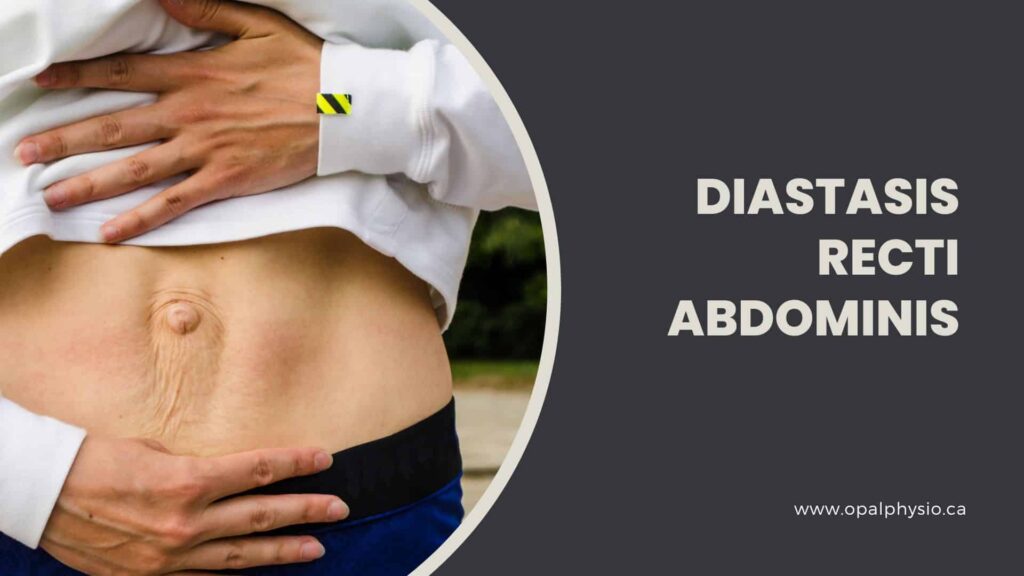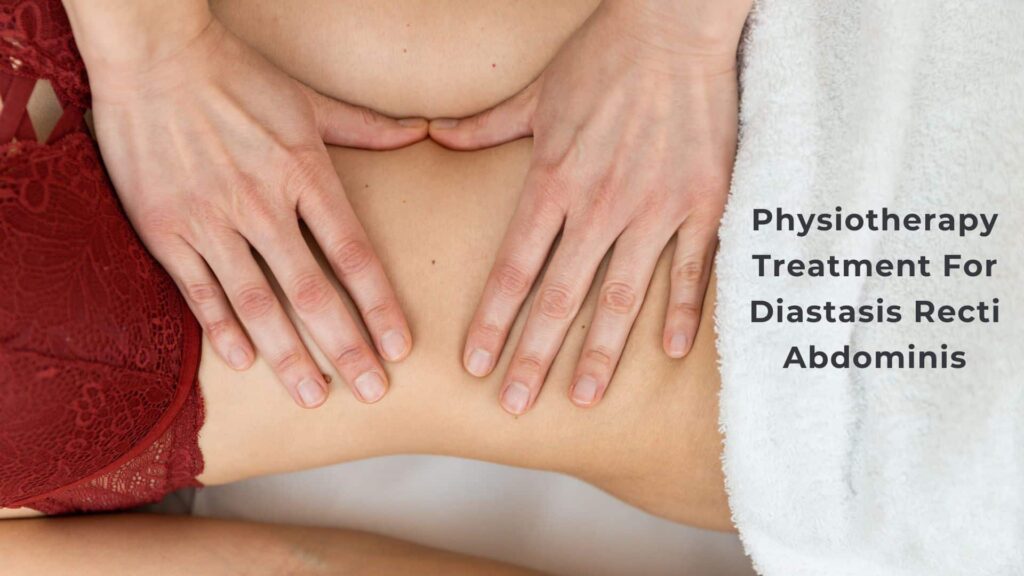Diastasis Recti – Abdominal Separation Physiotherapy
Diastasis Recti Treatment and Rehabilitation Services in Langley
Diastasis Recti (DR) is a condition where the abdominal muscles separate, resulting in a protrusion of the abdomen. It is a common condition that affects many individuals, particularly women, during and after pregnancy. It can lead to discomfort, weakness, and even long-term health issues if not properly addressed. Our highly skilled team of physiotherapists is dedicated to helping you regain your core muscle strength, function, and confidence following the separation of your abdominal muscles.

At our state-of-the-art physiotherapy clinic, we understand the importance of a strong and healthy core. Our diastasis recti rehabilitation program combines research-based techniques with personalized care to ensure you receive the most effective treatment tailored to your unique needs.
Whether you are experiencing pain or instability or want to improve your core strength, our compassionate and knowledgeable therapists will work closely with you to develop a customized plan to help you achieve your goals.
Let our pelvic floor physio guide you on your journey toward recovery and provide the expert care and support you need to overcome diastasis recti and embrace more confidence.
Diastasis Recti
Diastasis recti is a surprisingly common condition also known as rectus abdominis diastasis or diastasis recti abdominis. It occurs when the tummy muscles separate due to pregnancy or weight gain. The pelvic floor and core muscles are often weakened, and core stability becomes compromised, leading to backache and hip pain. Physiotherapy can relieve these symptoms and help improve core strength with exercises targeting the abdominal and deep core muscles.
Performing the appropriate sequence of increasingly challenging exercises is one of the most effective ways the physio can help you feel more comfortable in your abdominal region. These exercises will help reduce any discomfort you may be experiencing, enhance your core strength from within, and enable you to feel more strong.
Causative Factors of Diastasis Recti
The reasons for the separation of the abdominal muscles are:
- Pregnancy: There is rapid fetus growth during the second and third trimesters. The fast fetus growth enlarges the uterus, causing the widening of the stomach due to pressure. In most cases, the diastasis resolves after childbirth simply because the enlarged uterus and the pressure are gone. After birth, the abdominal muscle connective tissue gradually comes back together and heals without treatment. However, in some cases, the separation remains.
- Multiple pregnancies: Having more than one fetus exerts more pressure on your abdomen earlier. In most cases, the diastasis recti do not resolve because of the extreme enlargement of the stomach to accommodate the multiple fetuses.
- Several pregnancies: The number of times you get pregnant increases your chance of developing abdominal separation. Relaxin and estrogen hormones act on the joints and connective tissues each time you are pregnant, making stretching easy. Repeated stretching will increase your separation ( also called inter recti distance).
- Abdominal Obesity: Men and women can have diastasis due to excessive fat accumulation and unhealthy feeding (overeating), which strains the abdominal muscles and causes them to separate and function sub-optimally.
- Exercise: Wrong lifting technique and heavy weightlifting method can overstretch your abdominal muscles, thus splitting connective tissue. You can partially or entirely separate the linea alba by doing wrong exercise techniques or excessive heavy abdominal exercises.
- Vaginal delivery: This requires pushing out your baby, and as you push, you exert too much pressure on the abdominal muscles. The abdominal muscles are overstretched from an enlarged uterus, and with vaginal delivery, further stretching happens because of pushing, which pulls the abdominal connective tissue further apart.
- Premature child: Underdeveloped abdominal muscles are present in some premature babies. Because the muscles are not fully developed, there is little or no connective tissue binding them together. The good news is that the diastasis closes as the baby matures, but sometimes a hernia may appear if the abdominal muscles fail to close up.
Identifying Diastasis Recti
These underlying factors can make you notice some significant clinical symptoms of diastasis rectus abdominis. Though there are many complications of untreated abnormal abdominal separation, the early development of the disorder shows no attention-grabbing signs or symptoms.
Here are a few changes you may notice.
- Flabby stomach: You will feel reduced tonicity in the stomach muscles. It means that abdominal muscle diastasis cannot resolve because the muscles are weak.
- Protruded stomach: The internal organs are held in place when the abdominal muscles are bound together, giving your stomach a good form. With diastasis recti separation, your stomach will appear big and out of shape.
- Palpable abdominal separation: You can put your fingers below or above your navel and feel a gap or partition.
These underlying clinical symptoms come with no pain or other difficulty, but there could be complications if untreated.
The complications of diastasis recti
The abdominal muscles separation can cause several complications, including:
- Hip and low back pain: When the muscles of the trunk (abdomen and back) and hip muscles become weak, one of the muscle’s weaknesses can cause the other core muscles to be overworked, causing hip and low back pain from overstraining.
- Hernia: Diastasis recti can increase the risk of developing a hernia, which occurs when an organ or tissue protrudes through a weakened area in the abdominal wall.
- Poor posture: As the abdominal muscles weaken and separate, the pelvis can tilt forward, causing poor posture and strain on the lower back.
- Core muscle weakness: The separation of the abdominal muscles can weaken the core, making it difficult to perform certain exercises and day-to-day activities that require core strength.
- Digestive issues: A weakened abdominal wall can affect the function of the digestive system, leading to issues such as bloating, constipation, and discomfort.
- Incontinence: Increased pressure from the abdominal organs can weaken the pelvic floor muscle and cause ineffective functioning of pelvic floor muscles, causing urinary incontinence.
- Breathing difficulty: Abdominal muscles play a significant role in breathing. Therefore, a threat to your stomach muscles jeopardizes normal breathing.
- Poor balance: Impaired function of the core muscles due to diastasis recti abdominis can cause instability or lack of balance.
- Body image issues: Diastasis recti can cause a noticeable bulge in the abdomen, affecting a person’s body image and self-esteem.
It’s important to note that not everyone with diastasis recti will experience these complications, and many people can manage their symptoms with exercises and physical therapy. These complications are avoidable with proper treatment.
Available Treatment Options For Diastasis Recti:
The two evidence-based treatments for rectus diastasis are:
- Surgery
- Physiotherapy
Surgery: You may undergo an open or laparoscopic surgical approach. The surgery involves stitching the connective tissue together. Usually, surgery becomes an option when physiotherapy fails to reduce the abnormal widening of the abdomen. The open surgical method requires more incisions and leaves more significant scars.
Physiotherapy: is crucial in the effective management of diastasis rectus abdominis. If you think you might have a diastasis recti, the first thing to do is consult a physiotherapist trained in pelvic floor rehabilitation.
Physiotherapy Treatment For Diastasis Recti:

Physiotherapy treatment for diastasis recti focuses on strengthening the abdominal muscles and reducing their separation. The evaluation will include history and subjective assessment, objective strength testing, palpating the abdomen with fingers, and measuring the gap. Your physiotherapist will evaluate you subjectively and objectively before designing the best treatment plan.
Treatment goals
- Reduction of the abnormal abdominal widening
- Pain reduction
- Improve muscle strength
- Enhance stability
- Correct or prevent further complications.
Physiotherapy treatment technique for diastasis recti
- Patient education: Your physiotherapist will educate you on rectus diastasis to help you manage your expectations and reduce your fear and anxiety about diastasis. You will discuss your concerns and goals to create management plans. You will receive an effective and safe functional approach for fast recovery.
- Deep breathing exercise: The training challenges the abdominal muscles, thus improving their strength.
- Postural training: Relieving low back and hip pain requires strengthening your core muscles, especially the abdominal muscles. Correcting posture can help reduce pressure on the abdominal muscles and improve the spine’s alignment.
- Pelvic floor exercises: These involve contracting and relaxing the pelvic floor muscles. This helps support the organs and reduces pressure on the abdominal muscles.
- Core strengthening exercises: These involve strengthening the muscles of the abdomen, back, and pelvis. This training will include core strength, proper lifting techniques and weight training.
- Abdominal bracing exercises: These exercises involve contracting the transverse abdominis muscle, which is the deepest layer of abdominal muscles. This helps support the organs and reduces the separation between the abdominal muscles.
Our pelvic health physiotherapists are trained clinicians capable of evaluating and effectively treating your diastasis recti abdominis. Physiotherapy treatment can enhance the binding of the separated linea alba, eliminate complications, boost self-image perception, and improve quality of life.
Our therapist will assess your abdominal profile, posture, general health, and core and pelvic floor muscles during physiotherapy consultation. Once we understand the size of your diastasis recti, we will provide a tailored treatment plan for you.
If you notice abnormal widening of your stomach or are concerned that you have a diastasis, speak to our pelvic physiotherapist TODAY.
